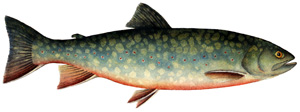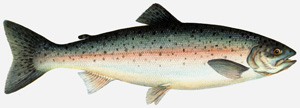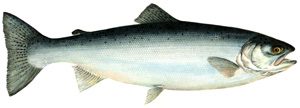Farmed Trout



Credit: Brenda Guild
Names:
Rainbow trout / Steelhead (Oncorhynchus mykiss), Brown Trout (Salmo trutta), Lake trout / Lake char (Salvelinus namaycush) and Brook Trout / Speckled Trout (Salvelinus fontinalis)
Locations:
Alberta, British Columbia, Manitoba, New Brunswick, Newfoundland and Labrador, Nova Scotia, Ontario, Quebec, Prince Edward Island, and Saskatchewan
Methods:
Juveniles: land-based hatchery facilities (flow-through and recirculation)
Grow-Out: freshwater net pens, saltwater net pens (for Steelhead culture), land-based raceways, and ponds
Broodstock: land-based (flow-through and recirculation)
At a Glance
Rainbow trout and Brook trout are the most common freshwater fish farmed in Canada. Rainbow trout that spend part of their life at sea or are farmed in saltwater are referred to as Steelhead trout. Ontario is the largest trout producer in Canada. In addition to commercial trout production, there are many privately owned operations that grow trout for enhancement or recreational fishing purposes. Trout is the third most valuable species raised in Canada in terms of farm-gate value. Most rainbow trout is exported to the United States.
Value
The annual average farm-gate value of trout culture in Canada was $40.7 million in the last five years (2011-2015). Ontario’s trout culture represents almost 50% of this total. The farm-gate value represents a product’s value once it is sold by the producer.
Production
An annual average of 7,000 tonnes of trout was produced in the last five years (2011-2015) in Canada. Ontario produced 55% of this amount. Trout production in Ontario is located in two principal areas: south-western Ontario, which primarily grows fingerlings for stocking or enhancement; and northern Ontario, where most grow-out sites are located in the waters of Georgian Bay and around Manitoulin Island in the North Channel of Lake Huron.
Quebec is a also an important producer of trout, with Rainbow trout and Brook trout as its main farmed species. Aquaculture activities in Quebec’s freshwater are performed throughout the province of Quebec, with some concentrations in the Estrie, Laurentians, Outaouais, and Centre-Quebec regions.
Rainbow trout is the most important aquaculture species in Saskatchewan. Commercial production in the province is found almost entirely in the Lake Diefenbaker area.
For more information on aquaculture’s impact, consult Aquaculture statistics and reports.
- Community Profile: Northern Ontario
- Community Profile: Waycobah First Nation, Nova Scotia
- Community Profile: Millbrook First Nation, Nova Scotia
Regulations
Trout farming is comprehensively regulated at the federal, provincial and territorial levels to ensure that farms maintain the highest standards of food safety, animal health, and environmental sustainability. Provincial and territorial governments also have regulatory responsibilities in licensing farm sites and processing plants. Management of the aquaculture industry is based on science and also incorporates traditional and local knowledge.
Licences to cultivate trout in British Columbia are administered by Fisheries and Oceans Canada as authorized through the Pacific Aquaculture Regulations. In British Columbia, provincial legislation guides the administration of aquaculture site tenures.
- Aquaculture regulations and policies
- Roles and responsibilities
Scientific Research
Scientific research informs the development of, and decisions related to, trout farming regulations in Canada. This includes regulations that serve to prevent any negative effects of trout-farming on water quality and the environment. Science related to trout aquaculture has focused on advanced feed technology and feeding techniques to ensure that the maximum amount of trout feed is absorbed by the fish. Research on freshwater culture has also studied trout health issues, such as bacterial coldwater disease.
- Date modified: